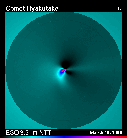Comet Hyakutake - Update (March 28, 1996)
Read More:

Dust Jets (ESO NTT Image)
This is another update to my earlier reports about observations of this comet, published on the ESO Web on March 12 , March 22 , March 25 and March 26 . It is based on information received directly by email and also from IAU Circulars and on other Hyakutake WWW pages.
Richard M. West (ESO)
March 28, 1996; 01:00 UT
Comet Hyakutake has now passed its northernmost point in the sky and has begun to move south again. In the course of the last 48 hours, its tail has swung and now points towards North-East. Its length is still very considerable.
First radar contact with Comet Hyakutake
Steve Ostro (JPL, Pasadena) informs that the first radar echo (March 24) has been obtained from Comet Hyakutake by means of the Goldstone X-band radar which operates at a frequency of 8510 megahertz (a wavelength of 3.5 cm).
In each of several dozen transmit-receive cycles, a 480-kilowatt signal was transmitted towards the comet, and echoes were received 107 seconds later. The echoes show the presence of a nucleus as well as a coma of particles that are not much smaller than one centimeter, and whose radial velocities with respect to the nucleus reach at least 10 meters per second. These observations have also resulted in a number of extremely accurate positions of the comet which have been used to improve the orbit (see below).
The attempts to continue the radar observations have not been without problems. Quotes from the published reports: March 25: We obtained some additional echoes from the comet despite equipment problems that wiped out most of the track. Signatures of the nucleus and coma are similar to those from March 24. March 26-27: We are beset with serious system problems.
Steve Ostro also mentions that in preparation for observations of Hyakutake and the asteroid (2063) Bacchus, it was decided to set up a public interface that would provide some information about asteroid radar that would be intelligible and interesting to a wider audience, from asteroid scientists through the public. This most instructive homepage contains general information about asteroid radar . Another is available for more specific information about the Hyakutake radar schedule and results .
Hubble Space Telescope images
A series of four HST images with explanation has been published.
The images show with great clarity the jets near the nucleus and also the condensations reported from ground-based observations. The scientists, headed by Hal Weaver, hope to disentangle the image of the nucleus from the surrounding coma, but it is still difficult to estimate its true size.
New and improved orbit
The latest orbit by Don Yeomans (JPL), is based on 387 positions, including the recent radar positions.Because the radar data are so powerful for orbit improvement, the attached ephemeris data should be accurate to the 1 arc second level through the end of March.
Brightness and tail length
From the recent cometary magnitudes of the International Comet Quarterly, it is seen that, as expected, the visual magnitude culminated on March 25. On this date, the mean of 14 recorded magnitude estimates is +0.1 (range from +0.9 to -0.8). On March 26, the mean of 14 estimates was +0.2 (range +0.9 to -0.4) and on March 27, 6 estimates give a mean of +0.4 (range +1.3 to +0.2).
It is now established that the (ion) tail length reached a length of at least 100 degrees - this is the maximum length recorded by visual observers on the best (darkest) sites. Very few comets in historical time have ever displayed a tail of such an extreme length.
Fragments in the tail
The French observers at the Pic du Midi Observatory, headed by J. Lecacheux, have provided a detailed description of the observed condensations in the tail (IAUC 6354). They noted a significant brightening of the inner tail region between March 21.2 and 21.9; this effect is probably connected to the surface processes which one day later thereafter manifested themselves in the outward moving condensations.
As already mentioned in my report on March 26, it does not appear that the nucleus has split in the usual sense of this word (this has been reported in some media). The fragments which broke off are most likely very small (and shortlived) as compared to the main nucleus. Observations of these fragments have also been reported by the HST, with a telescope at the Wendelstein observatory (see the images displayed at the Bavarian section of the ESO Hyakutake homepage), as well as with the Italian TIRGO Infrared telescope (IAUC 6357), the latter quoting a velocity of 17 m/sec for one of the condensations.
New IUE spectral observations
Michel Festou and collaborators have again obtained UV spectra with the International Ultraviolet Explorer satellite observatory (IAUC 6355). An important result is the recording of a dramatic (seven-fold) increase in the OH-production (and therefore in the water production) as the comet's heliocentric distance decreased from 1.15 to 1.05 AU. The measured production, 3.5 10e29 mol/sec, is almost exactly as high as the maximum measured from Comet Halley during its 1986 passage. However, at the time of that measurement Halley was closer to the Sun (0.7 AU) than Hyakutake. Thus, Comet Hyakutake is now clearly more active than Halley. It is not yet known whether this is due to a larger nucleus or because the dust and gas production per surface area is larger.
The IUE spectra show a large number of emission lines. Among those identified so far are lines from C2, CS, CO2+, NH, C, O, CO and S.